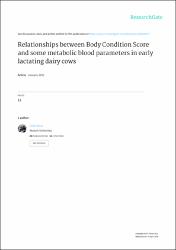| dc.contributor.author | Aktaş, Mustafa | |
| dc.contributor.author | Özkanlar, Seçkin | |
| dc.contributor.author | Uçar, Ömer | |
| dc.contributor.author | Özkanlar, Yunus Emre | |
| dc.contributor.author | Kaynar, Özgür | |
| dc.contributor.author | Aytekin, İsmail | |
| dc.date.accessioned | 2019-10-16T11:25:26Z | |
| dc.date.available | 2019-10-16T11:25:26Z | |
| dc.date.issued | 2011 | en_US |
| dc.identifier.issn | 0035-1555 | |
| dc.identifier.uri | https://hdl.handle.net/20.500.12462/7077 | |
| dc.description | Aytekin, İsmail (Balıkesir Author) | en_US |
| dc.description.abstract | The objective of the present study was to investigate the relationship between body condition score (BCS) and some metabolic blood parameters in postpartum (60 +/- 10 days) non-pregnant dairy cows. The animals stemming from 2 farms in Erzurum province were assigned into two groups according to their BCS as thin cows (group I, n = 6, BCS: 2.29 +/- 0.04 units) and normal cows (group II, n = 8, BCS: 2.81 +/- 0.05 units) and in parallel, serum biochemical parameters were determined. BCS has significantly differed between the 2 groups and was significantly correlated with AST (aspartate aminotransferase) activity and BUN (blood urea nitrogen) concentration. In cows with medium BCS, the mean glycaemia was significantly depressed compared to the thin animals whereas significant increases in mean BUN and AST activity were observed. In addition, although the mean values have not significantly differed between the 2 groups, it was also recorded that BHBA (beta-hydroxy butyric acid), triglyceride and VLDL (very low density lipoproteins) concentrations and the proportions of free fatty acids tended to slightly increased in the group II, suggesting strengthened lipomobilisation whereas the LDL (low density lipoproteins) concentrations and cholesterolemia at a lesser extent tended to decrease. Slight increases in proteinemia and albuminemia noted in the group II were coupled with mild decreases in minerals, indicating low perturbations in the hydro-electrolytic equilibrium. The fT(3) (free triiodothyronine) concentrations remained similar between the 2 groups. These results suggest that the negative energy balance was more pronounced in cows with medium BCS, leading to a higher risk for metabolic disorders and that thyroid hormones appeared to be weakly involved in the regulation of lipid metabolism in the early lactation period. | en_US |
| dc.description.sponsorship | Commission for Ataturk University Scientific Research
2009/287 | en_US |
| dc.language.iso | eng | en_US |
| dc.publisher | Ecole Nationale Veterinaire Toulouse | en_US |
| dc.rights | info:eu-repo/semantics/openAccess | en_US |
| dc.subject | Dairy Cows | en_US |
| dc.subject | Early Lactation Period | en_US |
| dc.subject | Body Condition Score | en_US |
| dc.subject | Negative Energy Balance | en_US |
| dc.subject | Serum Lipid Profiles | en_US |
| dc.subject | Metabolism Disorders | en_US |
| dc.title | Relationships between body condition score and some metabolic blood parameters in early lactating dairy cows | en_US |
| dc.type | article | en_US |
| dc.relation.journal | Revue De Medecine Veterinaire | en_US |
| dc.contributor.department | Veteriner Fakültesi | en_US |
| dc.identifier.volume | 162 | en_US |
| dc.identifier.issue | 12 | en_US |
| dc.identifier.startpage | 586 | en_US |
| dc.identifier.endpage | 592 | en_US |
| dc.relation.publicationcategory | Makale - Uluslararası Hakemli Dergi - Kurum Öğretim Elemanı | en_US |


















